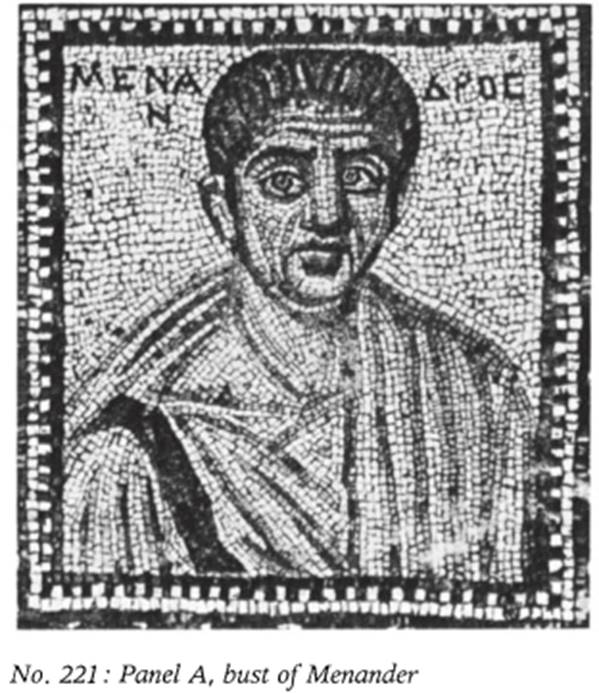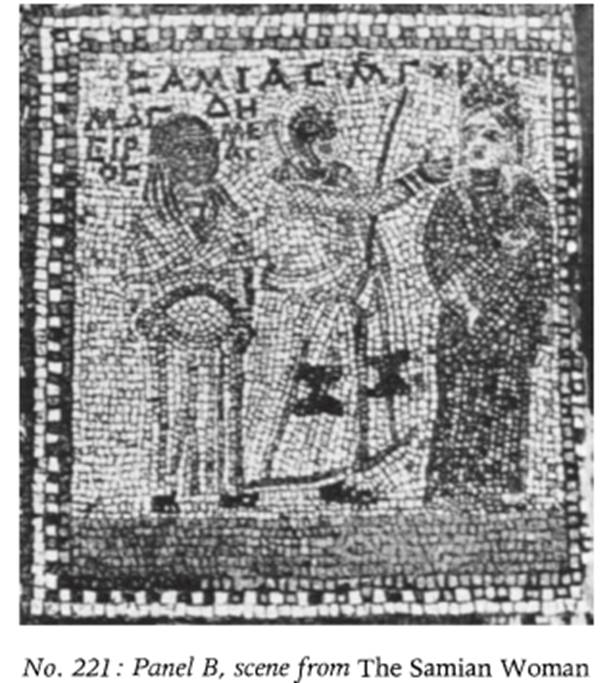Mosaic with Menander and a scene from The Samian Woman. Mytilene, Lesbos, late 3rd century
In 1961-1962 excavations at Mytilene on the island of Lesbos brought to light several rooms of a late Roman house with extensive mosaic pavements. A dining room (triclinium) and an adjacent portico had as their subjects nine scenes from the comedies of Menander, as well as an inscribed portrait of the playwright. The ten scenes in the dining room were placed in three rows, framed by a simple guilloche.

A: The head of Menander is depicted frontally against a white ground. His melancholy face is lined, his brow furrowed. His left eye is curiously askew, reminding us of the literary sources that record that Menander was cross-eyed. The poet wears a tunic and a cloak with a broad purple band. The mosaic worker's fondness for linear abstraction is apparent in the drapery and the geometric structure of the head. The grim honesty of the face finds stylistic parallels in sculptured portraits of the late third century, like that of Philip the Arab; even so, the features bear a striking resemblance to the much earlier sculptural portrait type that has been recognized as Menander (Richter, 1965, II, pp. 224—236), an identification supported by the present portrait.
The portrait is also quite similar to the medallion portrait of the Roman playwright Terence, the frontispiece of an illustrated Terence of the Carolingian period in the Vatican (Charitonides, Kahil, and Ginouves, 1970, pi. 2, fig. 2). The Terence portrait certainly reflects an earlier classical model, and it seems reasonable to conclude that the Menander portrait—and the other scenes from his plays—were derived from analogous illustrated manuscripts of the plays of Menander. Such simple medallion portraits were probably placed at the beginning of each of the individual plays, corresponding to their original separation into single papyrus rolls (Weitzmann, 1959, pp. 116-127). It is interesting in this regard to note that the series of Mytilene panels "reads” from left to right, starting with the portrait—as though one were following a text.
В: Three characters from Menander's lost play The Samian Woman stand on an unadorned stage against a neutral ground; they wear masks and costumes. At the right is Chrysis, holding a newborn baby to her breast; she wears a mask with the high wiglike hair known as the speira. Haranguing her in the center is Demeas, who wears the mask of an old man, with wispy beard.

At the left is the cook Mageiros, wearing a dark mask. The inscriptions include the title of the play, the names of the actors, and even the number of the act (it is the third). We know the outlines of the plot: Chrysis has adopted her lover Moschion's child by another woman, whom Moschion is now to marry; but his father Demeas (who has conveniently been abroad) suspects that the child is really Chrysis', and is now turning against her. The complex comedy of errors has a happy outcome; the Mytilene panel depicts the moment of greatest tension and misunderstanding. The simple style is very close to the narrative scenes in the illustrated manuscript of Terence, where there are also labels and no scenery. Menander remained the most popular of the Greek comic poets throughout antiquity. Archaeological evidence indicates that the house at Mytilene was destroyed in the last quarter of the third century; the mosaics were installed not much before that time.
Date added: 2025-08-31; views: 82;
